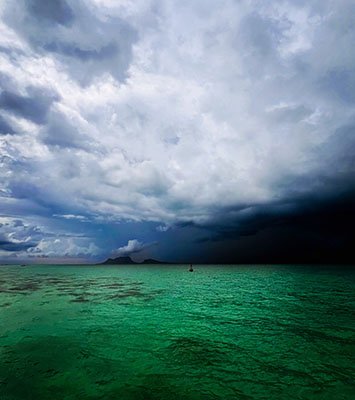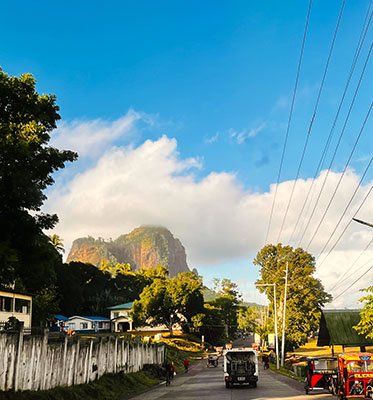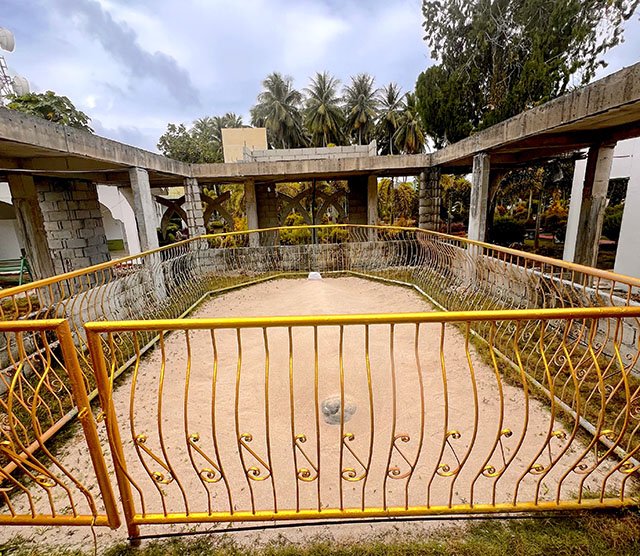Charmed at the Fringes

Bud Bongao as seen from the sea in late afternoon
At the end of January, I had a trip to Cotabato City. To be at the check-in counter on time, I got up and ready earlier in the morning. After two hours on the plane, I arrived in Cotabato before noon. It was thus a long morning bringing a long month to a close. Cotabato was just a transit point.
The following day I took an even earlier flight to accompany some friends to a place I had never visited, Tawi-Tawi. They had to be in Tawi-Tawi for work, and I was invited to tag along. Knowing the little that I knew, I had some perceptions of the province, along with one memory related to it.
It was an English class in my freshman year of high school. For one reason or another, at that stage in my life, my eyebrows were constantly furrowed. In the middle of class, our teacher, who was in the twilight of her career, noticed them and blurted, “Why are your eyebrows like that? You look like someone from Tawi-Tawi!” Her remark drew laughter from my classmates. I suppose to most people Tawi-Tawi was Muslim; Muslims looked angry, and I was one of them. The fact that I didn’t have any connections to the place was irrelevant.
Filipinos, as did the Spaniards and Americans, treat the Islamized ethnolinguistic groups of Mindanao and the Sulu Archipelago as an amalgam—Moro. To the outsider, they share a common religion, and owing to this assumption, the Tausug, Sama, Maranao, Maguindanaon, etc. are lumped together. I had a Muslim sounding name and was part-Maguindanaon. That was good enough for everyone to find our teacher funny.

everyday view Bud Bongao from a street in Bongao
Images, Fringes
I was lucky to be seated on the right side of the plane. Before landing in Sanga-Sanga airport and barely awake, I caught a glimpse of Bud Bongao, a rocky prominence strewn with foliage that welcomed with a genial dignity. I tried my best to hold on to the impression considering my somnolent state. Bud is mountain in Bahasa Sug or Sinug, the language of the Tausug that closely resembles some forms of Bisaya.
Sanga-Sanga is an island that is connected by bridge to Bongao Island; Bongao is the province’s capital and is connected to Tawi-Tawi Island, the province’s largest and namesake. It is the Philippines’ southernmost province, a cluster of islands closer to Borneo than to Mindanao. Today, the waters that surround the islands are the porous fringes of the country. There was a time, however, when the islands were in the middle of the Sulu Sultanate, back when the polity’s borders extended from Sabah on one end and the tip of the Zamboanga Peninsula on another.
On the way to the restaurant for lunch, I got to see Bud Bongao yet again, more awake and from a different perspective this time. Lunch abided by a standard Filipino conception of a special meal: carbohydrates in the form of rice and pancit (noodles), fried chicken, bistek (beef and onion), and the main feature—sweet and sour lapu-lapu (grouper). The others were adequate but, of course, it was the fish that provided the most conspicuous reminder of where I was.

One of the many variations of Sweet and Sour Lapu-lapu served in Tawi-Tawi
Lapu-lapu and other reduplicated words Tawi-Tawi and Sanga-Sanga became constant parts in our conversations throughout the weeklong trip. In almost every place we visited, a version of sweet and sour lapu-lapu was served. We were indeed treated to a variety. In all instances, the lapu-lapu were deep-fried then bathed and lacquered in sauces whose purpose is to strike a balance between delicate briny flesh and syrupy sharpness. I imagine that the preparation was a novelty once upon a time, since neither pineapple nor ketchup is produced in the area. With all its flavor, colors, and festive flair, the dish has become a token of Tawi-Tawi hospitality.
One of best lapu-lapus was the one we had in an island called Simunul. As the site of the country’s first mosque, Simunul is a place of importance among Filipino Muslims. According to local lore, it was erected by the Arab missionary Sheikh Karim ul Makhdum who came in the 14th century. His arrival marked the appearance of Islam in the Sulu Archipelago. More than a century later, my direct ancestor Sharif Kabungsuwan brought the religion to the Mindanao mainland. In time, Islamic conventions became dominant in the two areas. Both Makhdum’s grave and mosque are found in one compound, and they are now popular attractions for visitors to the island. We enjoyed our lapu-lapu in a home that was a stone’s throw away.

Macaques
Next
As the week progressed, I found it easier to get out of bed. My body had somehow adjusted to waking up before dawn, but my mind was still pretty much out of commission until noon. In the middle of the trip, I was given the opportunity to climb Bud Bongao with friends. The morning of the climb, elation conquered languor since I finally had a chance to make the mountain’s acquaintance, having only seen it from a distance.
As a tourism initiative, the ascent was made more accessible by constructing cement steps over the contour of the trail. Over the years, I’ve developed a fondness for forests. Not only did I learn about the role that they play in protecting wildlife and water, I also appreciated the contrast from the city life I normally endure. Salubrious air and quiet vis-à-vis pollution and frenetic noise. The climb, made easy by concrete, was a welcome pleasure. Several times, I made brief stops to catch my breath and take in the scenery.
The mountain’s autochthonous macaques present themselves at some point, having become accustomed to treats like bananas sold at the base. Midway, the sun was obscured by overcast skies; moments later, my companions and I were unprepared for rain and were drenched. Further into the trail, we came across two unexpected features. I hadn’t done any reading on Bud Bongao, so the two tampat or shrines close to the summit came as a surprise.

Macaques in the forest of Bud Bongao, their habitat
Suddenly, I was flung back to four years ago when I joined a pilgrimage to the tombs of the Sufi “saints” who introduced their Islam to Java. The familiar sight of people gathering and praying at the shrines gave comfort as I walked past in wet clothing. Upon looking into it, the tombs were purportedly of Makhdum’s followers. The term tampat for grave-shrines is also familiar because of its usage in Maguindanao. Pious supplication near the graves of people believed to have a special connection to the divine is a Sufi practice that was welcomed by communities across maritime Southeast Asia. I was glad to discover that the practice had persisted throughout the centuries.

One of the two tampat or grave-shrines on Bud Bongao
By the time we reached the peak, the rain had eased off into a drizzle. The altitude of our position gave an impressive view of Bongao, the horizon, and the water in between. Apart from the sense of achievement, there was also a feeling of peace. Peace is likewise a reality in Tawi-Tawi. The province is relatively peaceful compared with others in the region.
Like all other provinces in the Philippines, Tawi-Tawi is a place where different cultures have converged. The islands’ indigenous inhabitants, various groups that fall within the broader Sama or Badjao category live in harmony with the Tausug, some of whom migrated from nearby Sulu. One of the locals shared that in recent memory, people from Sulu crossed the water and moved to Tawi-Tawi to escape violence and live in peace. Migrants who have roots in other parts of the Philippines live and coexist without worry with the Sama and Tausug as well. Not far from the construction site of a large mosque in Bongao is the largest Christian church in the region. Elsewhere in the country, peace and coexistence or simply living, are still distant aspirations. In Tawi-Tawi, they are enjoyed every day.
“When we dare to push further into our mind, we realize the frivolity in drawing up divisions—Sama and Tausug, Moro and Filipino, Muslim and Christian, night and morning, and even curses and charms.”
The week that I spent in Tawi-Tawi spurred a couple of musings. Being on the edge of the Philippines, I became more convinced that borders, for the most part, exist only because they are imagined. When we dare to push further into our mind, we realize the frivolity in drawing up divisions—Sama and Tausug, Moro and Filipino, Muslim and Christian, night and morning, and even curses and charms. In my first trip to Tawi-Tawi, I realized that my erstwhile curse was in fact a charm. Waking up early allowed me to connect with nature, revel in rain, listen to stories, and feel the warm radiance of people’s smiles as they live peacefully at the fringes of imagination.

Datu Shariff Pendatun is an essayist and chef from Manila. As a writer, his primary field of interest is the interaction of Southeast Asian cultures through the lens of food.







No comments:
Post a Comment